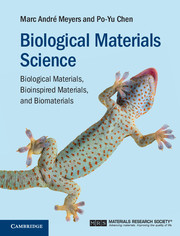Book contents
- Frontmatter
- Epigraph
- Contents
- Preface
- List of Boxes
- 1 Evolution of materials science and engineering: from natural to bioinspired materials
- Part I Basic biology principles
- Part II Biological materials
- 6 Silicate- and calcium-carbonate-based composites
- 7 Calcium-phosphate-based composites
- 8 Biological polymers and polymer composites
- 9 Biological elastomers
- 10 Biological foams (cellular solids)
- 11 Functional biological materials
- Part III Bioinspired materials and biomimetics
- References
- Index
11 - Functional biological materials
from Part II - Biological materials
Published online by Cambridge University Press: 05 August 2014
- Frontmatter
- Epigraph
- Contents
- Preface
- List of Boxes
- 1 Evolution of materials science and engineering: from natural to bioinspired materials
- Part I Basic biology principles
- Part II Biological materials
- 6 Silicate- and calcium-carbonate-based composites
- 7 Calcium-phosphate-based composites
- 8 Biological polymers and polymer composites
- 9 Biological elastomers
- 10 Biological foams (cellular solids)
- 11 Functional biological materials
- Part III Bioinspired materials and biomimetics
- References
- Index
Summary
Introduction
Materials can be divided into two classes: structural and functional. Structural materials are the ones where mechanical properties are of foremost importance: strength, hardness, toughness, ductility, and density are some of their most important characteristics. Functional materials, on the other hand, have other primary attributes: optical, magnetic, electrical, superconducting, and energy storage are some of the more important properties for which they are developed.
In biological materials, these boundaries are not so clear because many are multifunctional. Nevertheless, some have as primary function the sustainment of the structure, while others have other functions as principal attributes.
In this chapter, we present the principles of attachment with emphasis on gecko feet, which are, not coincidentally, the subject of the cover of this book. This is a fascinating subject, and several research groups are feverishly working on it with the goal of creating synthetic reversible attachment devices. Next we present the superhydrophobic effect through which the surface of the lotus plant remains clean. Water simply rolls off the surface, taking with it all particles. Another interfacial property that is important is the shark skin; the scales have a morphology and configuration that generate microvorticity in the water, decreasing drag. Biological materials and systems also have outstanding optical properties: chameleons change color through a complex interplay of chromatophores, for example. Some butterflies have wings with features that act as photonic arrays. The deep blue of the Morpho butterfly is the result of the interaction of the light with nano-scale arrays. The iridescent feathers of some birds are the result of the interference of light with arrays on the barbules, which have a periodicity close to the wavelength of light. The iridescent throat patch of humming birds is an eloquent example. We review these and some other aspects in this chapter. The presentation is by no means exhaustive, but illustrates the nature of functional biological materials.
- Type
- Chapter
- Information
- Biological Materials ScienceBiological Materials, Bioinspired Materials, and Biomaterials, pp. 452 - 496Publisher: Cambridge University PressPrint publication year: 2014



